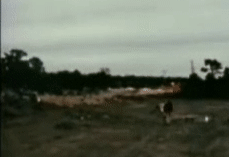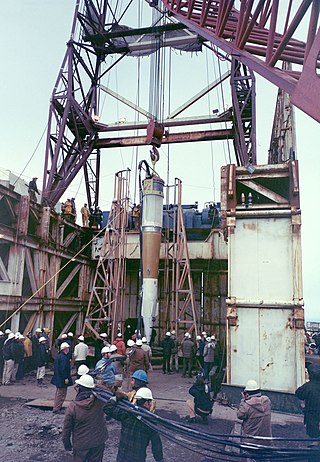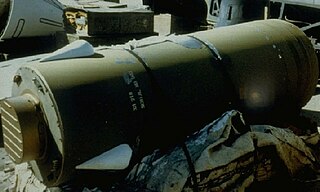Related Research Articles

The Nevada National Security Sites, popularized as the Nevada Test Site (NTS) until 2010, is a reservation of the United States Department of Energy located in the southeastern portion of Nye County, Nevada, about 65 mi (105 km) northwest of the city of Las Vegas.

Project Plowshare was the overall United States program for the development of techniques to use nuclear explosives for peaceful construction purposes. The program was organized in June 1957 as part of the worldwide Atoms for Peace efforts. As part of the program, 35 nuclear warheads were detonated in 27 separate tests. A similar program was carried out in the Soviet Union under the name Nuclear Explosions for the National Economy, although the Soviet one consists of 124 tests.

The United States's Whetstone nuclear test series was a group of 46 nuclear tests conducted in 1964–1965. These tests followed the Operation Niblick series and preceded the Operation Flintlock series.

Operation Crosstie was a series of 48 nuclear tests conducted by the United States in 1967–1968 at the Nevada Test Site. These tests followed the Operation Latchkey series and preceded the Operation Bowline series.

Nuclear weapons tests are experiments carried out to determine the performance, yield, and effects of nuclear weapons. Such tests have resulted until 2020 in up to 2.4 million people dying from its global fallout. Testing nuclear weapons offers practical information about how the weapons function, how detonations are affected by different conditions, and how personnel, structures, and equipment are affected when subjected to nuclear explosions. However, nuclear testing has often been used as an indicator of scientific and military strength. Many tests have been overtly political in their intention; most nuclear weapons states publicly declared their nuclear status through a nuclear test.

Project Chariot was a 1958 United States Atomic Energy Commission proposal to construct an artificial harbor at Cape Thompson on the North Slope of the U.S. state of Alaska by burying and detonating a string of nuclear devices.

Amchitka is a volcanic, tectonically unstable and uninhabited island in the Rat Islands group of the Aleutian Islands in southwest Alaska. It is part of the Alaska Maritime National Wildlife Refuge. The island, with a land area of roughly 116 square miles (300 km2), is about 42 miles (68 km) long and 1 to 4 miles wide. The area has a maritime climate, with many storms, and mostly overcast skies.
Peaceful nuclear explosions (PNEs) are nuclear explosions conducted for non-military purposes. Proposed uses include excavation for the building of canals and harbours, electrical generation, the use of nuclear explosions to drive spacecraft, and as a form of wide-area fracking. PNEs were an area of some research from the late 1950s into the 1980s, primarily in the United States and Soviet Union.

The W71 nuclear warhead was a US thermonuclear warhead developed at Lawrence Livermore National Laboratory in California and deployed on the LIM-49A Spartan missile, a component of the Safeguard Program, an anti-ballistic missile (ABM) defense system briefly deployed by the US in the 1970s.

Underground nuclear testing is the test detonation of nuclear weapons that is performed underground. When the device being tested is buried at sufficient depth, the nuclear explosion may be contained, with no release of radioactive materials to the atmosphere.

Project Gnome was the first nuclear test of Project Plowshare and was the first continental nuclear weapon test since Trinity to be conducted outside of the Nevada Test Site, and the second test in the state of New Mexico after Trinity. It was tested in southeastern New Mexico on December 10, 1961, approximately 40 km southeast of Carlsbad, New Mexico.

Pahute Mesa or Paiute Mesa is one of four major nuclear test regions within the Nevada National Security Site (NNSS). It occupies 243 square miles (630 km2) in the northwest corner of the NNSS in Nevada. The eastern section is known as Area 19 and the western section as Area 20.
Amchitka Air Force Base is an abandoned Air Force Base located on Amchitka, in the Rat Islands group of the Aleutian Islands in southwest Alaska.

Cannikin was an underground nuclear weapons test performed on November 6, 1971, on Amchitka island, Alaska, by the United States Atomic Energy Commission. The experiment, part of the Operation Grommet nuclear test series, tested the unique W71 warhead design for the LIM-49 Spartan anti-ballistic missile. With an explosive yield of almost 5 megatons of TNT (21 PJ), the test was the largest underground explosion ever detonated by the United States.
H. V. Eastman Lake is an artificial lake in the Sierra Nevada foothills of Madera County, California. A small percentage of the northwest area of the reservoir is in Mariposa County. The lake was named in honor of Judge H. V. Eastman (1891–1972) who had served as Secretary Manager of the Chowchilla Water District.
Project Carryall was a 1963 United States Atomic Energy Commission (AEC) proposal to use nuclear explosives to excavate a path for Interstate 40 (I-40) and the Atchison, Topeka and Santa Fe Railway (AT&SF) through the Bristol Mountains of southern California. The project was proposed as a component of Project Plowshare, which sought ways to use nuclear devices in public works and industrial development projects.
Project Ketch was a 1964 United States Atomic Energy Commission (AEC) proposal to use nuclear explosives to excavate a natural gas storage reservoir in Pennsylvania. The project was proposed as a component of Project Plowshare, which sought ways to use nuclear devices in public works and industrial development projects. The project was the only Plowshare project proposed for the northeastern United States.
Project Travois was a 1966 U.S. Army Nuclear Cratering Group proposal to develop demonstration projects using nuclear explosives for dam construction. The project was proposed as a component of Project Plowshare, which sought ways to use nuclear devices in public works and industrial development projects. Several sites were considered in California, New Mexico, Idaho, and Oregon. None were pursued beyond studies, and all nuclear quarrying projects were abandoned by the end of 1968.
Project Thunderbird was a 1967 United States Atomic Energy Commission (AEC) proposal to use nuclear explosives to prepare coalbeds to gasify coal in place underground in Wyoming. The project was proposed as a component of Project Plowshare, which sought ways to use nuclear devices in public works and industrial development projects. The project aimed to exploit deep coal deposits to gasify them in situ with controlled combustion in the rubble chimney resulting from a deep nuclear detonation. The project was to be located on the border of Johnson County and Campbell County|, about 20 miles (32 km) west of Gillette, Wyoming, in the Powder River Basin.
References
- 1 2 Project Larkspur, Amchitka Island, Alaska, Investigations of Areas 1, 2, 3 and 4 (PDF) (Report). U.S. Army Engineer District, North Pacific Division, U.S. Corps of Engineers. March 1965. p. 1.
- 1 2 Larkspur report, pp. 6-7
- 1 2 3 4 5 6 7 8 9 Beck, Colleen M.; Edwards, Susan R.; King, Maureen L. (2011-09-01). "Project Ketch". The Off-Site Plowshare and Vela Uniform Programs: Assessing Potential Environmental Liabilities through an Examination of Proposed Nuclear Projects,High Explosive Experiments, and High Explosive Construction Activities (Report). Vol. 2. pp. 3-233–3-236. doi:10.2172/1046575.
- 1 2 Larkspur report, p.1
- ↑ Kohlhoff, Dean W. (2002). Amchitka and the bomb : nuclear testing in Alaska. University of Washington Press. pp. 34–35. ISBN 0-295-98255-1.